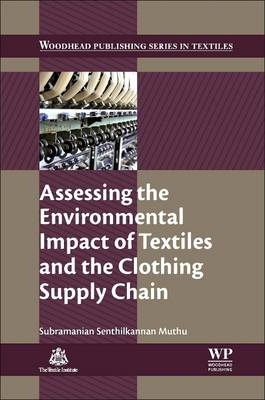
Assessing the Environmental Impact of Textiles and the Clothing Supply Chain
Woodhead Publishing Ltd (Verlag)
978-0-08-101394-6 (ISBN)
- Titel erscheint in neuer Auflage
- Artikel merken
The first chapters provide an introduction to the textile supply chain and its environmental impact, and an overview of the methods used to measure this impact. The book goes on to consider different environmental impacts of the industry, including greenhouse gas emissions, the water and energy footprints of the industry, and depletion of resources, as well as the use of LCA to assess the overall environmental impact of the textile industry. It then deals with the practice of measuring these impacts before forming a conclusion about the environmental impact of the industry.
Assessing the Environmental Impact of Textiles and the Clothing Supply Chain provides a standard reference for R&D managers in the textile industry and academic researchers in textile science.
Subramanian Senthilkannan Muthu is Eco-Design Consultant at SGS Hong Kong Limited. He completed his doctoral research study at the Institute of Textiles and Clothing, The Hong Kong Polytechnic University.
Author contact details
Woodhead Publishing Series in Textiles
Chapter 1: The textile supply chain and its environmental impact
Abstract:
1.1 Introduction
1.2 The textile supply chain: an overview
1.3 The production of natural fibres
1.4 The production of synthetic fibres
1.5 Spinning
1.6 Fabric manufacture
1.7 Finishing processes
1.8 Apparel manufacture
1.9 Distribution and retail
1.10 Usage and disposal
1.11 Summary: key challenges in assessing and reducing environmental impacts
Chapter 2: Ways of measuring the environmental impact of textile processing: an overview
Abstract:
2.1 Introduction
2.2 Ways of measuring the environmental impact of textile processing and textile products
2.3 Environmental legislation relating to textiles
2.4 Current environmental standards and schemes in the industry
2.5 Summary: key methods reviewed in this book
Chapter 3: Textile processing and greenhouse gas emissions: methods for calculating the product carbon footprint (PCF) of textile products
Abstract:
3.1 Introduction
3.2 The main principles of carbon footprint measurement
3.3 Carbon footprint assessment methodology
3.4 Applications of product carbon footprint (PCF) assessment to key stages in the supply chain
3.5 Application of PCF assessment in textiles
3.6 Summary: key challenges in calculating the PCF in textiles
Chapter 4: Calculating the water and energy footprints of textile products
Abstract:
4.1 Introduction
4.2 Water footprints: an introduction
4.3 Methods for assessing water footprints
4.4 Applications of water footprint assessment to key stages in the textile supply chain
4.5 Energy footprints: introduction and methods of assessment
4.6 Applications of energy footprint assessment to key stages in the textile supply chain
4.7 Summary: key challenges in calculating water and energy footprints
Chapter 5: Textile processing and resource depletion: calculating the ecological footprint of textile products
Abstract:
5.1 Introduction
5.2 Main principles and methods
5.3 Application to key stages in the supply chain
5.4 Summary: key challenges in calculating ecological footprints (EFs) in textiles
Chapter 6: Estimating the overall environmental impact of textile processing: life cycle assessment (LCA) of textile products
Abstract:
6.1 Introduction
6.2 History of life cycle assessment (LCA)
6.3 Basic principles of LCA
6.4 LCA goal and scope definition
6.5 Life cycle inventory analysis
6.6 Life cycle impact assessment (LCIA)
6.7 Life cycle interpretation
6.8 Standards for LCA
6.9 Different LCA methods
6.10 Different LCIA methods
6.11 Tools for calculation of LCAs
6.12 Advantages and limitations of LCA
6.13 Summary
Chapter 7: Life cycle assessment (LCA) and product carbon footprint (PCF) modelling of textile products
Abstract:
7.1 Introduction
7.2 Modelling for product carbon footprint (PCF) and life cycle assessment (LCA) of textile products
7.3 Available databases for LCA and PCF modelling of textiles and the clothing supply chain
7.4 Key issues in using databases
7.5 Difficulties in modelling and simulation
7.6 Summary
Chapter 8: End-of-life management of textile products
Abstract:
8.1 Introduction
8.2 End-of-life product management options
8.3 Reuse of textile products
8.4 Recycling of textile products
8.5 Incineration and landfilling of textile products
8.6 Biodegradation of textile products
8.7 Summary
Chapter 9: Measuring the environmental impact of textiles in practice: calculating the product carbon footprint (PCF) and life cycle assessment (LCA) of particular textile products
Abstract:
9.1 Introduction
9.2 Cotton clothing: life cycle assessment (LCA) studies of T-shirts
9.3 Cotton clothing: LCA studies of jeans
9.4 Woollen clothing: LCA study of a sweater
9.5 Synthetic clothing: LCA studies of polyester garments
9.6 Linen textiles: LCA of a linen shirt
9.7 Technical textiles: LCA studies of medical textile products
9.8 Nonwovens: LCA studies of nappies (diapers)
9.9 Summary
Chapter 10: Assessing the environmental impact of textiles: summary and conclusions
Abstract:
10.1 Introduction
10.2 Which assessment methods to use and when
10.3 Current problems in environmental assessment
10.4 Future trends
Index
| Erscheinungsdatum | 13.07.2016 |
|---|---|
| Reihe/Serie | The Textile Institute Book Series |
| Verlagsort | Cambridge |
| Sprache | englisch |
| Themenwelt | Naturwissenschaften ► Biologie ► Ökologie / Naturschutz |
| Sozialwissenschaften ► Politik / Verwaltung | |
| Technik ► Umwelttechnik / Biotechnologie | |
| Wirtschaft ► Betriebswirtschaft / Management ► Marketing / Vertrieb | |
| ISBN-10 | 0-08-101394-9 / 0081013949 |
| ISBN-13 | 978-0-08-101394-6 / 9780081013946 |
| Zustand | Neuware |
| Haben Sie eine Frage zum Produkt? |
aus dem Bereich



